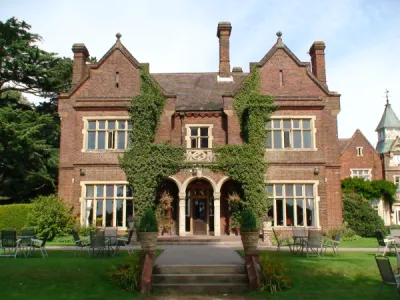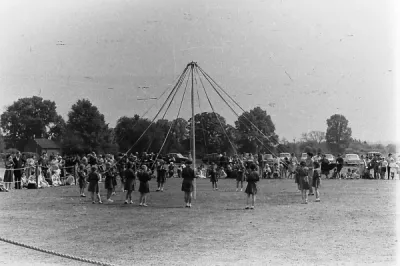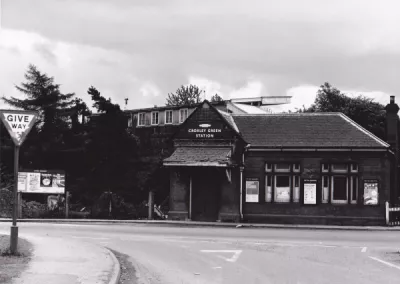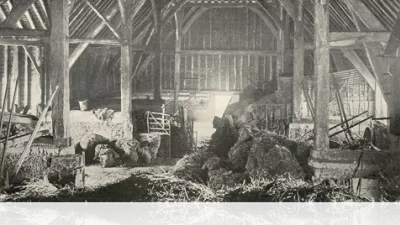Croxley Green
A village in its own right

Parts of what's now Croxley Green, particularly around Long Valley Wood, have been inhabited for many thousands of years, although whether continuously it's impossible to say. There is evidence of occupation in the Palaeolithic Age (10,000 – 4,000 BC), the Neolithic (4,000 – 2,000 BC), the Bronze (2,500 – 700 BC), the Iron (700 BC – 43 AD), the Roman (43 – 410 AD) periods and later. The number of palaeolithic finds from Long Valley Wood is much larger than would be expected from a small settlement, as are those from nearby sites, leading some researchers to speculate that perhaps “factories” existed producing tools for trade as well as local use.
The manorial system of government evolved across Europe in the centuries following the collapse of the Roman Empire. It is not known exactly when the Manor of Croxley was created, or what it was called at the time, but it certainly existed by c793 AD. It was then that Offa, King of Mercia, founded the Benedictine Monastery of St Albans (now the Abbey), endowing it with four local Manors, one of which was Croxley. At that time the Manor was probably simply a heavily wooded area, criss-crossed by tracks, with one or two clearings (possibly around what are now Croxley Hall Farm and The Green) and a handful of small farms and dwellings.
The origin of the name “Croxley” is not known. “ley” is a very common ending to place names across England, and probably derives from the Saxon word “leah” meaning 'a woodland clearing'. Some researchers suggest that a reference to “Croc’s Leah” in a 1016 report by Croc, a Moneyer (an official licensed to mint coins), may refer to Croxley, or it could be something else altogether – perhaps Croke’s Leah (see below) – we shall probably never know. Alternative spellings over the years include Crokesleya, Crokeslea, Crochesle, Crokesley, Crossley, Croxesly, Croleseigrene.
A knight of St Albans now known as Richard de Croxley (although his family name may have been Creke or Croke) is said to have given his mill at Croxley to the Nunnery of St Mary at Clerkenwell in 1166. The de Croxley family retained an interest in the Manor of Croxley, paying an annual fee to the Abbey, until c1310 when it reverted to the Abbey, The Manor remained in the possession of the Abbey until the Dissolution in 1539 when it became the property of the Crown. In 1557 the Manor was purchased by Dr John Caius, who then gave it to Gonville College, Cambridge.
Although there are thousands of village greens across the United Kingdom their origins are obscure. In Croxley’s case what is now “The Green” may well have been a part of the original settlement used for common grazing. Farms and dwellings would then have developed naturally around the periphery. Over time village greens were also used for recreational purposes – in Croxley’s case for the May Day celebrations, the August Monday Fair, cricket and football. There was also the Cherry Fair when, for three consecutive Sundays during the cherry harvest, stalls were set up between Stones Orchard and Parrots. So the Revels, the Steam Fair, Classics on the Green, CroxFest, and New Year’s Eve fireworks carry on an ancient tradition.
Common Land, usually less fertile areas not suitable for crops and used for grazing, was an integral part of medieval strip farming. As regards Croxley the Venn History of Gonville and Caius College states “The manor contained three tracts of common land, viz. Croxley Green, the Common Moor and the common land at Cassiobridge. From the earliest times payments amounting to 4s and called Haling Money have been paid to the College by the free or, since 1618, the free and customary tenants of the manor. Some portions of these payments are for permission to turn cattle on to the Common Moor; other portions are commutations in money for services which had originally to be rendered to the lord”.
For hundreds of years Croxley remained a small hamlet within the parish of Rickmansworth. According to Godfrey Cornwall’s research it was larger than today, the boundary running from Cassio Bridge past Little Green, Redheath and Micklefield, then along the Sarratt boundary to the River Chess, past Solesbridge Mill, Loudwater Mill, and Scotsbridge, and then back along the Gade to Cassio Bridge. The economy was wholly agricultural apart from three small water mills. As late as 1801 there were only 428 inhabitants, 85 families living in 66 dwellings, mainly located around The Green and the top of Scots Hill. Expansion, and transformation from a primarily agricultural economy, began with the opening of the Grand Junction Canal in 1805, which facilitated John Dickinson’s paper mill (opened in 1830), and the sale of Hollow Tree land for housing (New Road) in 1864. Growth was initially slow,as was usual in west Hertfordshire at this time, and the population reached only 1,180 in 1901, then 2,444 in 1921 and 3,295 in 1931. The arrival of the Metropolitan railway in 1925 and the subsequent “Metroland” development brought explosive growth, however, the population soaring to just over 11,000 by 1951. Today (2022) it is probably around 13,000.
Croxley Green is fortunate in having a strong local history group supported by the Parish Council. Their website is
here, and is well worth careful study.

Dickinsons were responsible for developing a great number of services and benefits for their staff and the other residents of the village. The image above shows the Maypole on the green during the Croxley Revels, which was well established in the early 1950s an came to the attention of John Betjeman when making his film 'Metroland' twenty years later. The maypole, however, was older, and residents recall it being stored under the stage of the Institute during World War 2.
Croxley Green was served by a branch line of the LMS Railway from Watford Junction, but road traffic took people to Watford more conveniently and it closed in the late 1990s. It is seen below in 1960. It had also been put on the Metropolitan Railway in 1925 on the branch to Watford, establishing Croxley Green firmly as part of Metroland.

A Chronology of Croxley Green
13th - 17th Century
1248 The farm (later Parrott’s) of Ralph Pyrot recorded
1278 The farm (later Durrant’s) of Simon Duraunt recorded
1291 Luke Bovingdon, a Cellarer of the Abbey, Lord of the Manor until 1295.
The Cellarer held a very important position, being responsible for everything necessary for the day to day running and upkeep of the Abbey – food, drink, fuel, transport, materials, etc. He would have been a frequent visitor to the Abbey’s outlying properties.
1310 Thomas de Bovingdene, a Cellarer of the Abbey, Lord of the Manor until 1313.
1320 William Heron, a Cellarer of the Abbey, Lord of the Manor until 1323.
1326 Abbot Richard Wallingford stayed at the Manor House (location not known although possibly close to today’s Croxley Hall Farm) on his way back to St Albans after visiting the Pope for confirmation of his Abbacy.
1381 The Peasants’ Revolt. The men of Rikemeresworth are said to have picked up those of Crokesley and Cassio on their way to St Albans in support of Watt Tyler.
1397 (about) Croxley Great Barn built. There must have been a farmhouse close by possibly on the site of the present Croxley Hall Farmhouse which is thought to date from c1650 (although now much altered) and was the Manor House at the time.
1525 Henry Baldwin of Redheath baptised at Watford.
1533 Thomas Whethstede, a Cellarer of the Abbey, Lord of the Manor.
1538 The Manor of Croxley leased to William Baldwyn of Red Heath for 44 years.
1545 The will of William Baldwyn named his son George as executor.
1553 The Manor of Croxley granted to Robert Lee by King Edward VI.
1557 Dr John Caius bought of the Crown (Philip and Mary) the Manor of Croxley and Snellshall for the sum of £461 being 20 years annual value. Dr Caius then gave the Manor to endow Gonville College Cambridge, which was then renamed Gonville and Caius College.
The will of George Baldwin left property to his wife Ellen (or Helen) and his under-age son Edmund. The Venn College History states that “this property included his lease of the Manor of Croxley which he had taken and bought of one Robert Lee which Lee had taken of “K Edward 6th” (ie King Edward VI).
1570’s The Venn History states, regarding the Manor, that “this property has been peculiarly productive of lawsuits”. This appears to relate to various suits in Chancery taken out against Edmund Baldwyn and others (including his mother now married to Thomas Tredwell) for alleged mismanagement and/or illegal use of land called Blounds or Blounts.
1618 Until this year Gonville and Caius had let the Manor to a single tenant who then let parts to others, but from now on the College let directly to various separate tenants.
Mid to late 1600’s Croxley’s earliest surviving houses are thought to date from around this time, possibly built on the sites of earlier dwellings, and now much altered over the years. They include Croxley Hall Farmhouse (the Manor House), Hollow Tree Farmhouse, Providence Hall, Parrott’s House and Granary, Killingdown Farmhouse, Little Green Cottages, and the Artichoke and Coach and Horses public houses.
1692 The population of Croxley estimated to be around 180 - 200 living in 45 houses.
Scotsbridge Mill known to be a fulling mill processing cloth. It is believed that a mill had existed on this site for hundreds of years.
18th Century
1709 Thomas Baldwin died leaving Red Heath to his nephew Charles Finch
1712 Charles Finch built a new Red Heath House on the site of a former dwelling which possibly dated back to Tudor times.
1752 It was estimated that the Manor comprised approximately 479 acres of meadow and arable lands and 91 acres of woods.
1757 Paper production started at Scotsbridge Mill
1767 Thomas Lord Hyde later (1778) the first Earl of Clarendon, bought two tenements, Harry Smith’s and Harwoods or Harwells; these tenements are known to have existed before 1620.
1770 Thomas Lord Hyde built Croxley House on the site of the former tenements
The road from Cassio Bridge to Rickmansworth – now Watford Road – was turnpiked as part of the Hatfield and Reading Turnpike.
1794 Thomas, second Earl of Clarendon, sold Croxley House to Humphrey Cornwall Woolrych
1797 The Grand Junction Canal open from trade from Watford to Brentford, cutting through parts of Common Moor and Cassio Bridge Common, land purchased from Gonville and Caius College, and Lott Mead. The Venn History of the College states that “Lott Mead was a meadow, partly freehold and part copyhold of the Manor, formerly owned by a number of persons who mowed it every year, drawing lots as to which portion each should mow. The Canal Company bought from the various owners the rights to Lott Mead and later sold to John Dickinson Company the two parts either side not required for the canal”.
1799 Humphrey Cornwall Woolrych bought Parrotts Farm which then became part of the Croxley House Estate
1805 The Grand Junction Canal open throughout, making Midlands coal and other manufactured goods widely available.
1819 Christopher Leach, aged 89, baptised at his home (Hollow Tree House) by Rev E Hodgson. It is believed he was not baptised as a child because his parents were Dissenters.
1828 Royal Assent given to a private Act of Parliament enabling John Dickinson Company to acquire land on which to build a paper mill
1830 The John Dickinson paper mill started production
1834 Miss Mary Bentley built “The Grove” originally known as “The Pavilion”, now converted to apartments
1854 A Post Office Receiving House opened in a cottage located at the junction of New Road and The Green (now known as South View). The Postmistress was Mrs Elizabeth East believed to be the widow of Thomas East, a blacksmith who had run a smithy at the top of what is now Copthorne Road.
1860 The Gonville and Caius College Statutes amended to permit the sale of manor land, banned under the previous statutes established by Dr Caius. This led to numerous transactions over the next sixty years or so, such as the development of Copthorne Road. Earlier sales of land to The Grand Junction Canal Company and to John Dickinson Company were specially authorised by private Acts of Parliament)
1864 Most of Hollow Tree Farm land sold to the British Land Company leading to the development of New Road
c1866/67 Durrants House built for Thomas Hoade Woods presumably on land purchased from Gonville and Caius College. But, strangely, neither the Venn History of the College, nor an index to to the College archives mention such a sale although later sales to Mr Woods are noted – 23 acres in 1880, 102 acres in 1895, and various smaller transactions. Eventually the Durrants estate totalled about 224 acres.
1868 A Methodist Chapel built towards the top of New Road
1872 All Saints Church consecrated 25th June, and subsequently the ecclesiastical parish of Croxley Green formed.
1875 Croxley Green First School (later Yorke Road) opened. The first Head Mistress was Miss Harriette Lawrence and the school catered for children aged 5 – 13. The school is now converted into flats.
1887 The Cooperative Society registered under the Friendly Societies Act.
Dickinson Square built on Milestone Field to provide houses for mill workers. Dickinson Avenue and Yorke Road (originally Garden Road) followed later.
1888 Watford Road, along with all other turnpike roads in England, dis-turnpiked.
1893 The Methodist Chapel replaced by a larger building
1894 The Old Boys School opened on land donated by John Dickinson Company, and providing for boys aged 7 and above. The Headmaster was Mr Alfred Walter Stratton- Hanes.
1895 The Dickinson Institute – later known as “The Tute” opened in a converted cottage provided by John Dickinson Company (32 Milestone Field Cottages, later renumbered 31 Dickinson Square) to provide a club and reading room for the villagers. It proved so popular that a separate hall was built the following year
1896 A Gospel Hall built for The Plymouth Brethren towards the top of Scots Hill
1897 Queen Victoria Jubilee Oak planted on The Green.
1898 Rickmansworth Urban District formed, including Croxley Green from Scots Hill to the end of New Road adjacent to the Red House pub.
20th Century
1901 A horse trough donated by The Metropolitan Drinking and Horse Trough Association installed at the top of Scots Hill. It's still there.
“Neggy Wilson” - who was later to become a Croxley legend – appointed Headmaster of the old Boys School.
1902 Rickmansworth Gravel Company formed and started gravel extraction at Croxley leading to the discovery of Palaeolithic occupation.
Gonville and Caius College sold Cassiobridge House plus 44 acres to Mr S W Greves.
1904 John Dickinson Company added a further building, facing New Road, to “The Tute”.
1906 Copthorne Road laid out on land belonging to Gonville and Caius College at a cost of about £2,290.
1907/08 All Saints Church enlarged.
1909 Croxley Green Scout Troop formed.
1911 Coronation of King George V Oak planted on The Green.
The LNWR Station opened.
1913 Croxley as far as Cassio Bridge added to Rickmansworth Urban District.
1913 A fire, possibly started by Suffragettes, destroyed the LNWR Station steps.
1915 – 19 “The Tute”, staffed mainly by Red Cross and St John’s volunteers, used as a convalescent home for wounded servicemen.
1919 The War Memorial erected on The Green and a commemorative Oak planted (replaced in the 1980s, after the original died).
1921 The first 'council houses' built in Gonville Avenue.
The Croxley Branch of the Royal British Legion founded.
1922 Red Heath sold to Lord Ebury for £27,000.
1925 The Metropolitan Line Station opened, as the railway extended to Watford.
1926 “The Tute” became known as the Guildhouse.
John Dickinson Company purchased land just off The Green for use as a sports ground.
1931 Headstone Estates bought the Durrants Estate, mainly for housing development.
1932 All Saints Church Hall built.
1935 King George V Silver Jubilee Oak planted on The Green.
Robert Egerton Grosvenor, Fifth Lord Ebury, came of age and sold the Red Heath Estate.
Merchant Taylors School bought Durrants House and 20 acres from Headstone Estates for use as a sports ground.
Durrants School, a senior elementary school, opened, Head Master Mr A E Jeffery. The old Boys' School was closed, although the building was used for some years as Further Education Centre for Adults and later as a centre for children with special needs.
1937 King George VI Oak planted on The Green. It later died, and was replaced in 1973.
St Oswald’s Church Hall built.
1938 The Croxley Green Society and the Croxley Green Residents Association formed.
1939 Harvey Road School, a Junior Mixed school, opened in a “temporary” wooden building; the Head Mistress was Miss Cooper.
1939 – 41 Croxley House leased to St Dunstan’s for use as a convalescent home for blinded servicemen.
1940 Two parachute mines exploded towards the top of Scots Hill causing extensive damage to All Saints Church and to housing; 13 casualties but no fatalities.
An oil bomb and two high explosive bombs dropped close to the Met Station destroying seven houses and damaging two others.
1944 Rickmansworth UrbanDistrict Council acquired Common Moor from Gonville and Caius College.
A parachute bomb exploded towards the top of Scots Hill destroying the Gospel Hall and six houses and damaging around two hundred others; twenty five casualties although no fatalities.
1945 Street parties held across the village to celebrate VE Day.
The Victory Oak was planted on The Green.
1946 (about) Croxley’s first County Library opened in a converted shop at 146 Watford Road; the Librarian was Miss J Hoyle (Mrs J Woodward).
1947 The Old Merchant Taylors Society (OMT) formed, with Durrants as its playing field.
1949 The WVS bought Croxley House to use as a residential home for 23 elderly people,
Malvern Way (Head Mistress Mrs C L Edwards-Carpenter) and Little Green (Head Master Mr W Worthy) schools opened
1951 In recognition of The Festival of Britain held that year, Croxley Green commemorated 100 years of history with a grand procession and fun fair. This can be seen as the start of the modern Revels.
1952 A Chapel of Ease (later St Bede’s church) built in Baldwins Lane for the Catholic Church.
1953 Queen Elizabeth II Coronation Oak planted on The Green.
1954 Rickmansworth School (located at the top of Scots Hill) opened; Head Master Peter Morrill; Head Mistress Mildred Collings.
1957 Rickmansworth Urban District Council acquired The Green from Gonville and Caius College.
1958 St Bede’s Church completed in Baldwins Lane.
1959 A replacement for the Gospel Hall (destroyed by bombing in 1944) built in Fuller Way; this later became an Explore Church.
1961 St Oswald’s Church Hall consecrated as a Church.
1965 The Dickinson Guildhouse destroyed by fire. The site was later developed as a block of flats.
Winston Churchill Fir planted on The Green.
1966 A purpose built County Library opened at the junction of New Road and Barton Way.
The Red Cross Centre opened, adjoining the Library, its primary purpose being to provide premises for a club and social centre for the elderly of Croxley. The cost was about £21,500, funded jointly by Hertfordshire County Council, Rickmansworth Urban District Council, the Red Cross Society and public subscription.
1968 York House School moved to Red Heath from Moneyhill House.
1970 The A412 at Cassio Bridge duelled, as the main road into Watford, and to Croxley paper mill, the Sun printers and the developing industrial parks nearby.
1970’s The Windmill Estate developed on the grounds of the former Highfield House.
1972 Scots Hill duelled, requiring extensive earthworks and embankment. “The Plough” and “The George and Dragon” public houses were among the buildings demolished to permit road widening.
Ownership of Croxley Great Barn transferred to Hertfordshire County Council.
1973 Restoration work on Croxley Great Barn
The Croxley Revels featured in John Betjeman’s BBC TV Documentary 'Metroland'.
Croxley Green Windmill listed at Grade 2.
1974 Croxley became part of the newly formed Three Rivers District.
1977 Croxley Green Community Association formed.
Queen Elizabeth II Jubilee Oak planted on The Green.
1980 John Dickinson’s paper mill closed.
The Green designated a Conservation Area.
Fred Housego, a London taxi driver living in Croxley Green, won the BBC’s “Mastermind”.
1981 The Green and Common Moor registered as Common land (initial application 1967).
1983 What was left of Stone’s Orchard, much having been sold for development, acquired by Three Rivers District Council for a nominal £1.
The John Dickinson sports ground sold to Three Rivers District Council for £1.
1986 The Common Moor designated a site of Special Scientific Interest.
Croxley Green Parish Council formed.
1987 Croxley Guild of Sport and Social Club formed.
1988 The Beefeater Restaurant Chain purchased Scotsbridge Mill.
1991 Durrants School closed, the buildings demolished, and most of the site redeveloped for housing.
1992/93 The Library was so badly damaged by a fire during the night of 29 December that it had to be demolished. The adjoining Red Cross Centre suffered extensive smoke damage but reopened within a few weeks.
1994 The rebuilt Library reopened.
1995 A walnut tree planted in Stone’s Orchard to mark the 50th Anniversary of the end of WW2 Walnut.
Ownership of Croxley Great Barn transferred to St Joan of Arc School.
Dickinson Square/Avenue designated a Conservation Area.
1997 The Old Boys School demolished and a block of flats (Magister’s Lodge) built on the site.
A modern, brick built, Harvey Road School opened in the existing grounds and the old wooden building demolished.
The Greensleeves Trust took over the WVS residential home at Croxley House.
2000 Millennium Oak planted on The Green.
2002 English Heritage placed Croxley Great Barn on the Buildings at Risk Register.
2007 Buddleia Walk/Long Valley Wood registered as a Village Green.
2015/16 The Old Merchant Taylors sports ground developed for housing; Durrants House retained, but converted to flats.
Repairs to Croxley Great Barn by volunteers from the Society for the Protection of Ancient Buildings.
